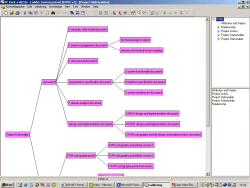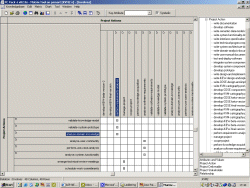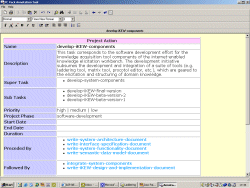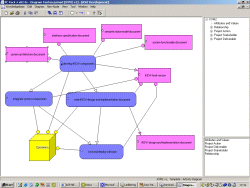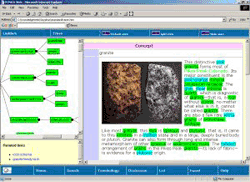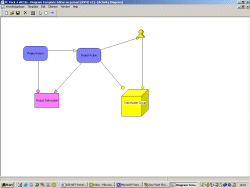PCPACK6 Technical Overview
PCPACK6 Tools
PCPACK was born out of academic research in the early 1990s involving Professor Sir Nigel Shadbolt's Artificial Intelligence Group at the University of Nottingham. The aim of this work was to define and explore ways in which software tools could help knowledge engineers to acquire knowledge for the development of knowledge-based systems (i.e. AI systems that emulate the reasoning of experts, such as a physicians or engineers).
PCPACK has continued to evolve since that time with the aim of development being to fully update the software to meet the requirements of both advanced Knowledge Engineering and Knowledge Management projects. There have been five major changes from previous versions.
- The number of tools has been rationalised to focus on those that are most often used in Knowledge Engineering and Knowledge Management projects
- Tool flexibility has been greatly enhanced thus allowing users to customise many aspects of the tools
- The user interface has been greatly improved to increase the ease of learning and using the tools
- A publishing capability has been added so that a website can be created "at the press of button"
- Export and import of RDF in three formats has been introduced (RDFS, OWL DL, and OWL FULL) alongside SKOS RDF (Simple Knowledge Organisation System)
To create a fully flexible tool, various templates have been included within PCPACK:
- Ontology templates: These are special forms of knowledgebase that are used as the basis for new knowledgebases.
- Diagram templates: These are used to define the format of diagrams used in the Diagram Tool.
- Annotation templates: These are used to define the structure, style and contents of annotation pages.
- Publication templates: These are used to define the structure, style and contents of the websites created using the Publisher Tool.
PCPACK is available in two versions:
- A network application that allows knowledgebases to be stored and accessed by multiple users over a network
- A single user version that operates on a local PC or laptop
PCPACK Tools
There are 10 tools in PCPACK: 5 acquisition and modelling tools, and 5 specialised tools.
Acquisition and Modelling Tools:
Specialised Tools:
- The ADMIN TOOL is used to access and manage knowledgebases.
- The PUBLISHER TOOL is used to create websites.
- The DIAGRAM TEMPLATE TOOL is used to create templates used in the Diagram Tool.
- The EQUATION EDITOR is used to create equations for use in the Annotation Tool.
- The TOOL LAUNCHER is a wizard tool allowing easy access to the other tools.
Interaction of Tools
The way the tools interact with the XML knowledgebase is shown below.
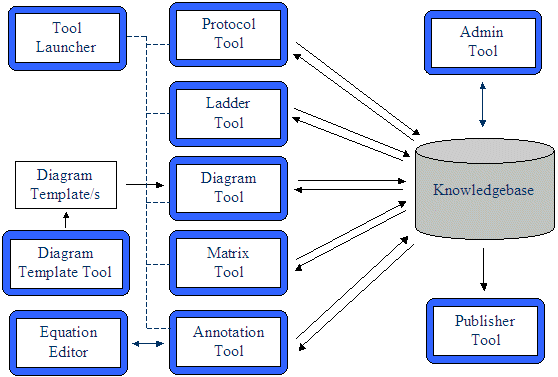
Academic Credentials
The development of PCPACK has involved a number of academic research projects. As such, PCPACK has been described and referenced in a number of academic papers and books. Should you be interested in this work, the following list (shown in chronological order) shows the key references.
- Shadbolt, N., Motta, E. & Rouge, A. (1993). Constructing Knowledge-Based Systems. IEEE Software, November 1993, p34-39.
- Motta, E. et al (1996). Solving VT in VITAL: a study in model construction and knowledge reuse. International Journal of Human-Computer Studies, Volume 44, p333-371.
- Goodall (Ed.) (1996). The PCPACK Knowledge Analysis Tool. AI Watch, Volume 5, p1-9.
- Zanconato, R. & Davies, A. (1997). Design for a Knowledge-Based Decision Support System to Assist Near Littoral Airborne Early Warning (AEW) Operations. Proceedings of the 4th Joint GAF/RAF/USAF Workshop in Human-Computer Teamwork. Kreuth, Germany.
- Montero, L. & Scott, C. T. (1998). Improving the Quality of Component Business Systems with Knowledge Engineering. Proceedings of the 11th Knowledge Acquisition for Knowledge-Based Systems Workshop. Banff, Alberta, Canada.
- O'Hara, K. & Shadbolt, N. R. & Van Heijst, G. (1998). Generalised Directive Models: Integrating Model Development and Knowledge Acquisition. International Journal of Human-Computer Studies, Volume 49, p497-522.
- Shadbolt, N. and Milton, N. (1999). From Knowledge Engineering to Knowledge Management. British Journal of Management, Volume 10, p309-322.
- Milton, N., et al (1999). Towards a Knowledge Technology for Knowledge Management. International Journal of Human-Computer Studies, Volume 51, p615-641.
- Shadbolt, N.R., Tennison, J., Milton, N. & Howells, H. (2000). Situation Assessor Support System: A Knowledge-Based Systems Approach to Pilot Aiding. Proceedings of the Annual Conference of the Ergonomics Society on Temporary Ergonomics - July 2000.
- Schreiber. A. Th., et al. (2000). Knowledge Engineering and Management: The CommonKADS Methodology. Cambridge: MA: MIT Press.
- McNeese, M. & Vidulich, M. (Eds.) (2002). Cognitive Systems Engineering in Military Aviation Environments. SOAR - April 02.
- Milton, N., Clarke, D. and Shadbolt, N. (2006). Knowledge Engineering and Psychology: Towards a closer relationship. International Journal of Human-Computer Studies, Volume 64(12), 1214-1229.
- Milton, N. R. (2007). Knowledge Acquisition in Practice. London: Springer.
- Milton, N. R. (2008). Knowledge Technologies. London: Springer.
Technical Details

Technology & Standards
- RESTful Services
- SPARQL 1.1
- Distributed RDF Modelling
- Semantic and Linked Data
- Enterprise Service Bus
- SOA
- SKOS Knowledge Organisation

System Requirements
- Win10 + other Windows operating systems (depending on your local configuration)
- Any Standards-compliant browser
For more about PCPACK - get in touch today
